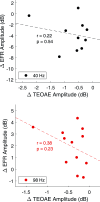Effects of contralateral noise on envelope-following responses, auditory-nerve compound action potentials, and otoacoustic emissions measured simultaneously
- PMID: 38445988
- PMCID: PMC10919957
- DOI: 10.1121/10.0025137
Effects of contralateral noise on envelope-following responses, auditory-nerve compound action potentials, and otoacoustic emissions measured simultaneously
Abstract
This study assessed whether the effects of contralateral acoustic stimulation (CAS) are consistent with eliciting the medial olivocochlear (MOC) reflex for measurements sensitive to outer hair cell (otoacoustic emissions, OAEs), auditory-nerve (AN; compound action potential, CAP), and brainstem/cortical (envelope-following response, EFR) function. The effects of CAS were evaluated for simultaneous measurement of OAEs, CAPs, and EFRs in participants with normal hearing. Clicks were presented at 40 or 98 Hz in three ipsilateral noise conditions (no noise, 45 dB SPL, and 55 dB SPL). For the no noise condition, CAS suppressed or enhanced EFR amplitudes for 40- and 98-Hz clicks, respectively, while CAS had no significant effect on CAP amplitudes. A follow-up experiment using slower rates (4.4-22.2 Hz) assessed whether this insignificant CAS effect on CAPs was from ipsilateral MOC stimulation or AN adaptation; however, CAS effects remained insignificant despite favorable signal-to-noise ratios. CAS-related enhancements of EFR and CAP amplitudes in ipsilateral noise were not observed, contrary to the anti-masking effect of the MOC reflex. EFR and OAE suppression from CAS were not significantly correlated. Thus, the effects of CAS on EFRs may not be solely mediated by the MOC reflex and may be partially mediated by higher auditory centers.
© 2024 Acoustical Society of America.
Conflict of interest statement
The authors have no conflicts to disclose.
Figures









Similar articles
-
Medial olivocochlear efferent reflex inhibition of human cochlear nerve responses.Hear Res. 2016 Mar;333:216-224. doi: 10.1016/j.heares.2015.09.001. Epub 2015 Sep 11. Hear Res. 2016. PMID: 26364824 Free PMC article.
-
Contralateral Inhibition of Click- and Chirp-Evoked Human Compound Action Potentials.Front Neurosci. 2017 Apr 4;11:189. doi: 10.3389/fnins.2017.00189. eCollection 2017. Front Neurosci. 2017. PMID: 28420960 Free PMC article.
-
[Efferent suppression test--sensitivity and specificity].Otolaryngol Pol. 2008;62(6):747-54. doi: 10.1016/S0030-6657(08)70352-4. Otolaryngol Pol. 2008. PMID: 19205524 Polish.
-
Olivocochlear efferents: anatomy, physiology, function, and the measurement of efferent effects in humans.Ear Hear. 2006 Dec;27(6):589-607. doi: 10.1097/01.aud.0000240507.83072.e7. Ear Hear. 2006. PMID: 17086072 Review.
-
Olivocochlear efferents: Their action, effects, measurement and uses, and the impact of the new conception of cochlear mechanical responses.Hear Res. 2018 May;362:38-47. doi: 10.1016/j.heares.2017.12.012. Epub 2017 Dec 21. Hear Res. 2018. PMID: 29291948 Free PMC article. Review.
References
Publication types
MeSH terms
Grants and funding
LinkOut - more resources
Full Text Sources
Miscellaneous

